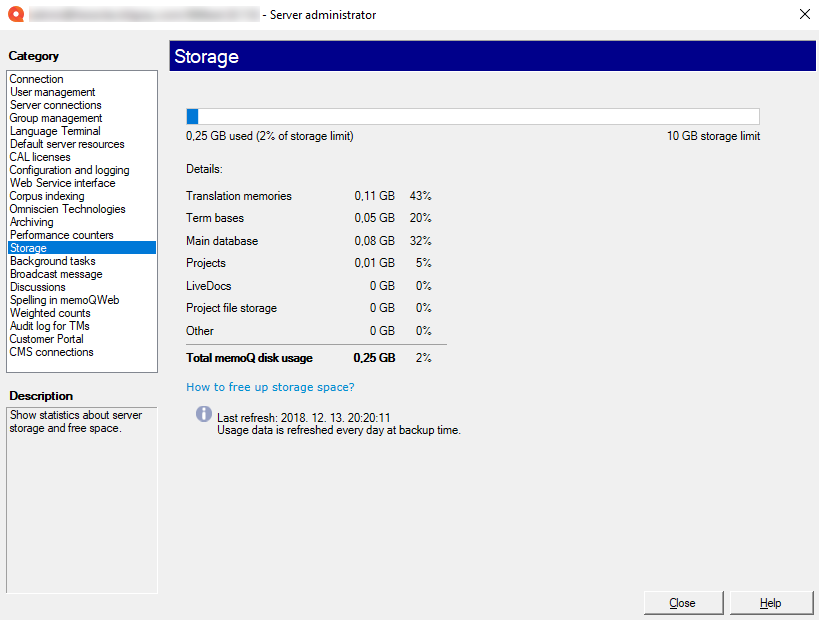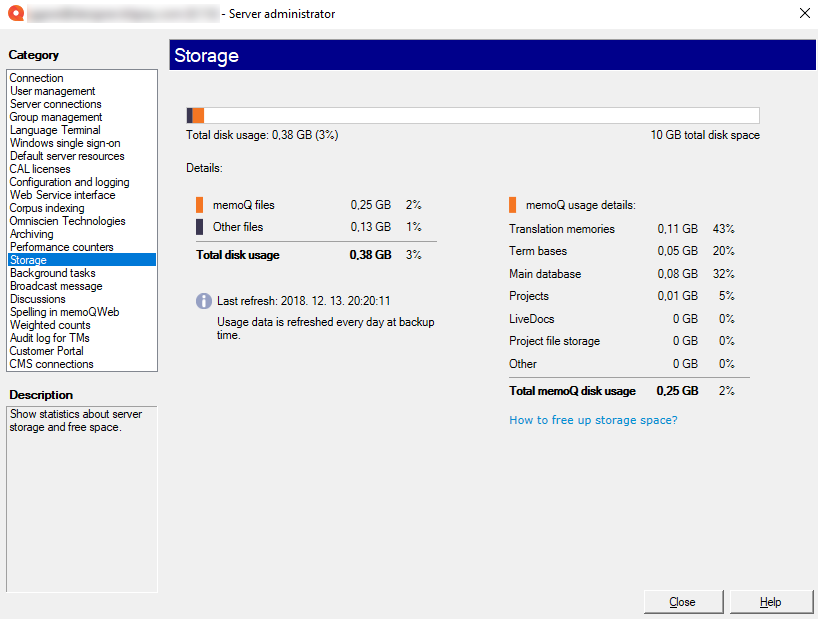Server administrator: Storage
For memoQ clouds, disk space is limited. At the time of writing (December 2018), memoQ clouds have 10 gigabytes.
Hosted memoQ servers do not have this limit, but the Storage pane still tells you how much disk space memoQ is using.
If you have your own memoQ server: Your system administrator can give you this information. Currently, the Storage pane is only available on memoQ clouds and hosted memoQ servers.
Requires memoQ project manager: You need the project manager edition of memoQ to manage a memoQ server or a memoQ cloud.
You need to be a project manager or an administrator: You may manage the server only if you are a member of the Project managers or Administrators group on the memoQ server. To change most settings, you must be member of the Administrators group.
How to get here
- At the very top of the memoQ window - in the Quick Access toolbar
 -, click the Server Administrator (cogwheel in a cloud)
-, click the Server Administrator (cogwheel in a cloud)  icon. The Server Administrator window opens, with the Connection pane.
icon. The Server Administrator window opens, with the Connection pane.Or: On the Project ribbon, click Server Administrator.
- Under Category, click Storage. The Storage pane appears.

Storage pane on a memoQ cloud
Storage pane on a hosted memoQ server
What can you do?
You can see how much space the different kinds of data (translation memories, term bases, etc.) take up. If this is over 80% of your storage, the blue bar (on memoQ cloud) or the Total disk usage information (on hosted memoQ servers) shows in yellow. Over 90%, they show in red. If you go over your memoQ cloud's storage limit, you cannot do anything before freeing up enough space.
How to free up storage space
Find out what kind of data causes the problem.
- Projects and documents: There can be more than one reason:
Lots of old or unused projects: On the memoQ Dashboard, select unneeded projects and on the ribbon, click Archive. in the memoQ archive projects wizard, type a folder path on your computer, or click Browse, and go to the folder you want to save the project archives. Archiving deletes the projects from your memoQ cloud or server.
You have to do this manually: Currently, the automated archiving actions in project templates put the archives on the same cloud or server. If you are using such automated actions, ask memoQ support for help.
- A few huge unfinished projects: Export unused or finished files to MQXLZ format, and remove them from the project.
- Translation memories:
- Unused or rarely used TMs: On the Resource console, delete these (you may want to export into TMX first), or remove them from the server (make sure to clear the Keep the remote copy after creating a local copy successfully check box). Removed TMs can be shared on the server again when needed.
- TMs used for a long time: In the Translation memory editor, use the Remove duplicates button. Or, filter for TM entries which are older than a date you choose, then export them to your computer, and delete them from the TM. You can also remove segments that contain only numbers or tags: run a QA on the TM to find them.
- Term bases:
- Lots of images: Resize the images to make the term base smaller.
- Lots of duplicate entries: This can occur if you import the same content (for example, an updated version of the same term sheet) regularly. In the Term base editor, use the Remove duplicates button.
- LiveDocs: On the Resource console, remove unused corpora from the server. Just like TMs, you can share removed corpora on the server when needed.
- Project file storage: These are the documents exported from memoQ. Download them to your computer and delete from memoQ cloud or server. If you have a memoQ cloud, ask memoQ support for help.
Find more explanations and tips in the Keeping your memoQ cloud slim guide.
When you finish
To return to memoQ: Click Close.
Or, choose another category to manage:
- Connection (choose this to manage a different server)
- User management
- Server connections
- Group management
- Language Terminal
- Windows single sign-on
- Default server resources
- CAL licenses
- ELM licenses
- Configuration and logging
- Web service interface
- Corpus indexing
- Omniscien Technologies
- Archiving
- Performance counters
- Storage
- Background tasks
- Broadcast message
- Discussions
- Spelling in memoQWeb
- Weighted counts
- Audit log for TM
- Customer Portal
- CMS connections